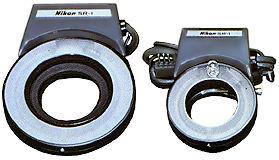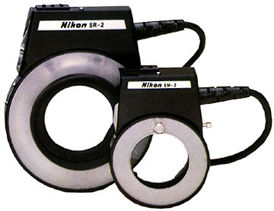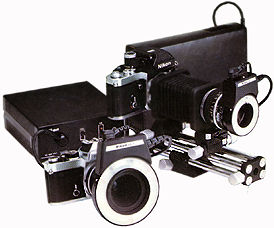|
Modern
Classic SLRs Series :
Nikon F & F2 Shared Resources:
Specialized Flashes - Ring Flash
|
| |

SM-1 Ringlight
- As with all ringlights, this unit is designed to provide shadowless
lighting for close-up subjects. It attaches to the rear of the lens via the bayonet
mount (it has a bayonet release lever similar to that on the M2-tube as well as a
semi-automatic diaphragm plunger). It is designed for photography at mag. ratios
greater than 1:1 with 24mm to 135mm lenses, reversed on bellows (via the BR-2). The
permanently attached cord has two plugs, a PC-type sync and a 4-pin power plug, which
attaches to the SB-1. There is a switch on the SM-1 to cut output from full to 1/4
power, but overall power is controlled from the SB-1. It has a small modeling light
built-in for ease of focussing when up close to the subject.
Different lenses have different exposure effects with the SM-1.
If I had some skill with cgi, I'd write a script to automatically look up the f/
stop based on your subject-to-film-plane distance. Unfortunately, you have to settle
for the following tables:
|
|
subject-fp f/distance
|
stop
|
|
for 24 f/2.8:
|
305 mm
|
5.6
|
|
|
250 mm
|
8
|
|
|
200 mm
|
11
|
|
for 35f/2.8, f/2, f/1.4 and 28f/3.5, f/2:
|
360 mm
|
5.6
|
|
|
305 mm
|
8
|
|
|
205 mm
|
11
|
|
|
195 mm
|
16
|
|
for 55f/3.5 and 50 f/2, f/1.4 and 45 f/2.8:
|
310 mm
|
11
|
|
|
240 mm
|
16
|
|
|
205 mm
|
22
|
|
for 105 f/2.5 and 85 f/1.8:
|
420 mm
|
11
|
|
|
300 mm
|
16
|
Note :
Chart is nonlinear with evenly spaced f/number progression;
ASA 100 @ 1/4 power (close two stops for full power, one stop for each ASA doubling)
When you use the above tables, note that extension factor has already been taken
into account, and the f/ stop indicated is as it should be set on the lens. The "chart
is (non)linear" notation indicates whether if, the data, when scatter-plotted
with distance on the y-axis and f/ stop progression (i.e. f/1.4, 2, 2.8, 4, 5.6,
etc.) spaced evenly on the x-axis, are linear or not. The linear ones may be linearly
interpolated, using the logarithm of the f/ stop.
SR-1 Ringlight
- As with all ringlights, this unit is designed to provide shadowless
lighting for close-up subjects. It attaches to the front of the lens via a 52mm threaded
ring, which may be turned via the knurled ring in the center of the flashtube housing.
A cord is permanently attached to this unit. The cord has two plugs on it; one is
a standard PC-type sync plug and the other is the 4-pin power plug, which attaches
to the SB-1 only. Thus for those of you who've scrounged up a spare SD-3 can't use
the SR-1 (or SM-1) with the SB-1 and SD-3. The SR-1's power is controlled via the
SB-1's power switch, and the SR-1 has a light-output switch which cuts the output
from full to 1/4 power.
The SR-1 is recommended for use for subject-to-film-plane distances
greater than 200mm. The guide number appears to be 14m (45.5ft) at ASA 100 and full
power. 1/4 power would require opening up two more stops. Since the SB-1/SR-1 is
a fully manual flash, without exposure confirmation, your best bet is either to obtain
and use a flashmeter, or use the guide number calculated above. A chart is included
below for your convenience:
|
subject-fp f/distance
|
stop
|
|
625 mm
|
5.6
|
|
500 mm
|
8
|
|
375 mm
|
11
|
|
250 mm
|
16
|
|
130 mm
|
22
|
Note :
Chart is nonlinear with evenly spaced f/number progression;
ASA 100 @ 1/4 power (close two stops for full power, one stop for each ASA doubling)
There's not much else to say. If you're a fan of flat, featureless
lighting, or have a burning need for a ringlight, you could probably do better than
an SR-1. More modern units will provide TTL flash metering, which is a godsend for
close-up photography. On the other hand, if you want to assemble the complete SB-1
system ...
SM-2 Ringlight

-
- Light Output Control:
- manual; full or 1/4 power
- Guide Number:
- not applicable
- Number of Flashes (appox.):
- 600 (LD-1, full, alkaline manganese batteries)
- 1 400 (LD-1, 1/4, alkaline manganese batteries)
- unlimited (LA-1)
- Recycling Time:
- appox. 12 sec.
- Angle of Coverage:
- sufficient for macro coverage
- Power Sources:
- LD-1 DC unit (8 1.5V "D"-type cells)
- LA-1 AC unit
- Ready-light:
- provided
- Open Flash/Test Firing Button:
- provided
- Modeling Lamp:
- provided; button-activated
- Synch Socket for Eyepiece Pilot Lamp:
- provided
- Ready-light Contact for F2 Series Camera Finders:
- provided with accessory SC-4
- Dimensions and Weight:
- 70 x 100 x 35mm; 185g without batteries
- 2.8 x 3.9 x 1.4 in.; 6.5 oz. without batteries
- Accessories:
- DC Unit LD-1
- AC Unit LA-1
- ready-light adapter SC-4
- sync cord SC-5
- coiled sync cord SC-6
- sync cord SC-7
- extension cord SE-2
- eyepiece pilot lamp SF-1
-
Visually, the SM-2 appears nearly identical to its predecessor,
the SM-1. The main differences are that the SM-2 has sockets instead of the SM-1's
permanently attached power and sync cords. The sockets on the SM-2 are similar to
other Nikon speedlites; there is the three-prong sync socket and a half-moon three-pin
power socket identical to the one on the later version of the Medical-Nikkor 200
(not wholly unexpected, as they share the same power supplies ...)
-
Although I am not completely sure, the specs and usage for
the SM-2 should be the same as those for the SM-1. The great advantage of using the
SR-2/SM-2 (instead of the the corresponding SR-1/SM-1 products) is in not being tied
to the SB-1 as a source of power, but rather being tied to largish, blocky power
packs. Yes, there's always the SB-21A/B, which offers TTL closeup flash at a price.
SR-2 Ringlight
- Light Output Control:
- manual; full or 1/4 power
- Guide Number:
- 16m (52 ft.) for ASA 100 film at full power
- 8m (26 ft.) for ASA 100 film at 1/4 power
- Number of Flashes (appox.):
- 600 (LD-1, full, alkaline manganese batteries)
- 1 400 (LD-1, 1/4, alkaline manganese batteries)
- unlimited (LA-1)
- Recycling Time:
- appox. 12 sec.
- Angle of Coverage:
- 65 degrees
- Power Sources:
- LD-1 DC unit (8 1.5V "D"-type cells)
- LA-1 AC unit
- Ready-light:
- provided
- Open Flash/Test Firing Button:
- provided
- Synch Socket for Eyepiece Pilot Lamp:
- provided
- Ready-light Contact for F2 Series Camera Finders:
- provided with accessory SC-4
- Dimensions and Weight:
- 140 x 106 x 25mm; 200g without batteries
- 5.5 x 4.2 x 1 in.; 7 oz. without batteries
- Accessories:
- DC Unit LD-1
- AC Unit LA-1
- ready-light adapter SC-4
- sync cord SC-5
- coiled sync cord SC-6
- sync cord SC-7
- extension cord SE-2
- eyepiece pilot lamp SF-1
-
Visually, the SR-2 appears nearly identical to its predecessor,
the SR-1. The main differences are that the SM-2 has sockets instead of the SR-1's
permanently attached power and sync cords. The sockets on the SR-2 are similar to
other Nikon speedlites; there is the three-prong sync socket and a half-moon three-pin
power socket identical to the one on the later version of the Medical-Nikkor 200
(not wholly unexpected, as they share the same power supplies ...)
-
Although I am not completely sure, the specs and usage for
the SR-2 should be the same as those for the SR-1. Again, remember that the SR-2
is appropriate for use down to 0.6m (2 ft.).
| Back | to Index Page of Flash
for Nikon F & F2
Would you get up and walk out on me? Thanks to
- Isaac Chan for providing important information on the SR-2 and SM-2 as well as
an interesting discussion on various mystery Nikon items.
Nikon Flash Units: BC-Series| Original Nikon Speedlight
SB-2
| SB-3
| SB-4
| SB-5
| SB-6
| SB-7E
| SB-8E
| SB-9
| SB-E
| SB-10
SB-11
| SB-12 | SB-14 | SB-140 UV-IR| SB-15 | SB16A | SB-17 |
SB-18, SB-19 | SR2/SM-2 Ringlights | SB-21A (SB-29) Macro flash |
Flash Accesories | SF-1
Pilot Lamp
Nikon AF-TTL Speedlights
| SB-20 | SB-22 | SB-23 | SB-24 | SB-25 | SB-26 | SB-27 | SB-28 | Nikon SB-29(s) | Nikon
SB-30
| Nikon
SB-600
| Nikon
SB-800
(updated)
Nikon AF-TTL Speedlight DX-Series: Nikon SB-28DX | SB-50DX | SB-80DX (updated)

| Back to Nikon F2 - Main
Index Page (NEW)
* Message Board for Nikon F2 Series Bodies
Main Reference map in HTML
& PDF:
Body with FTN Finder | FTN finder | camera body |
External
links
for F & F2
-

| Message
Board
| for Nikon F Series
SLR Camera(s)
| Message Board |
for your Nikon Optics in a shared environment
| Message Board |
Specifically tor Dispose or Looking for Nikon Photographic equipment
|
Back | to Nikon-F - Main Index Page
Nikon Auto Focus Nikkor lenses:-
Main Index Page
Nikon Manual
Focus
Nikkor lenses:- Fisheye-Nikkor Lenses - Circular | Full Frame |
Ultrawides Lenses - 13mm15mm18mm20mm | Wideangle Lenses - 24mm28mm35mm | Standard Lenses - 45mm 50mm 58mm | Telephoto
Lenses - 85mm105mm135mm180mm & 200mm | Super-Telephoto Lenses - 300mm 400mm 500mm 600mm 800mm 1200mm |
MF Zoom-Nikkor Lenses: 25~50mm | 28~45mm | 28~50mm | 28~85mm | 35~70mm | 36~72mm E | 35~85mm | 35~105mm | 35~135mm | 35~200mm | 43~86mm | 50~135mm | 50~300mm | 70~210mm E | 75~150mm E | 80~200mm | 85~250mm | 100~300mm | 180~600mm | 200~400mm | 200~600mm | 360~1200mm | 1200~1700mm
Tele-Converters: TC-1 | TC-2 | TC-200 | TC-201 | TC-300 | TC-301 | TC-14 | TC-14A | TC-14B | TC-14C | TC-14E | TC-16 | TC-16A | TC-20E
Recommended links to understand more technical details
related to the Nikkor F-mount and production Serial Number:
http://www.zi.ku.dk/personal/lhhansen/photo/fmount.htm by: Hansen,
Lars Holst
http://www.mir.com.my/rb/photography/hardwares/nikonfmount/lens2.htm
http://www.photosynthesis.co.nz/nikon/serialno.html


Copyright
© 1998. Michael C. Liu ®
Site
rearranged by: leofoo ®.
Credit: Hiura Shinsaku® from
Nikomat Club of Japan for feeding some useful inputs on the introductory page.
The great 3D logo by Kiasu; Ted Wengelaar®,
Holland for his continuous flow of input of early Nikon bodies. Stephen Gandy's Cameraquest; Marc Vorgers from Holland for
his additinal images on Nikon F Apollo; Hayao Tanabe
corrected my Red Dot and Early F assertions. Gray Levett, Grays of Westminster
publishes an excellent monthly historical look at Nikon products, from where I learned
about the high-speed F's. Made
with a PowerMac, broadcast with
a Redhat Linux
powered server.
 |
Home - Photography in Malaysia
|
 |





